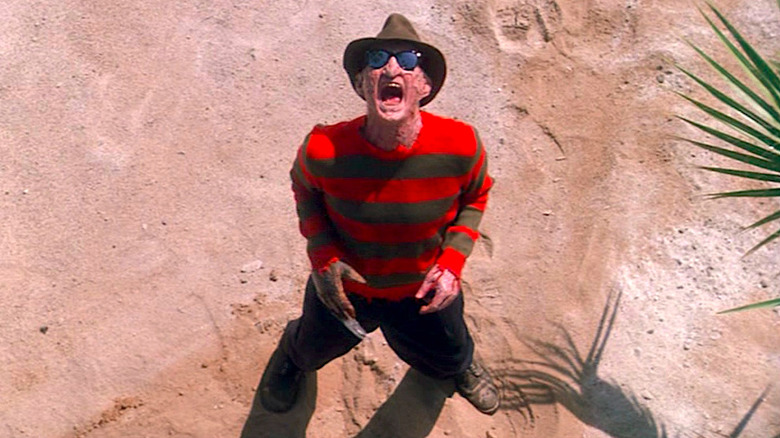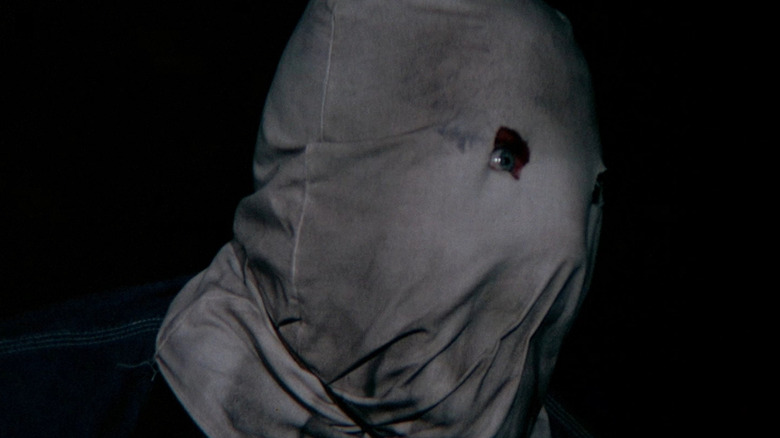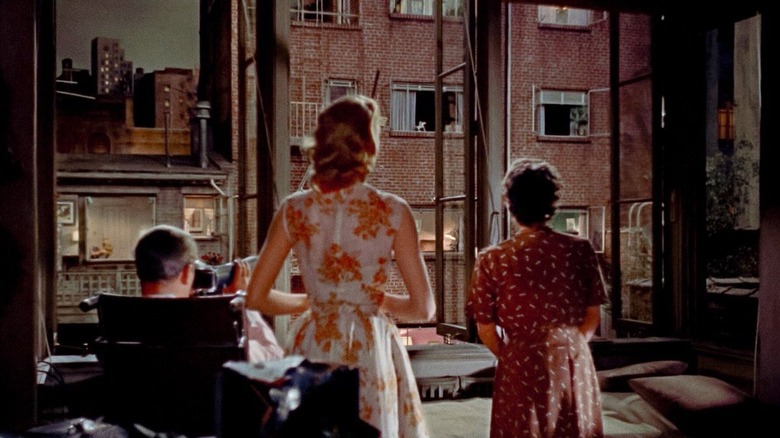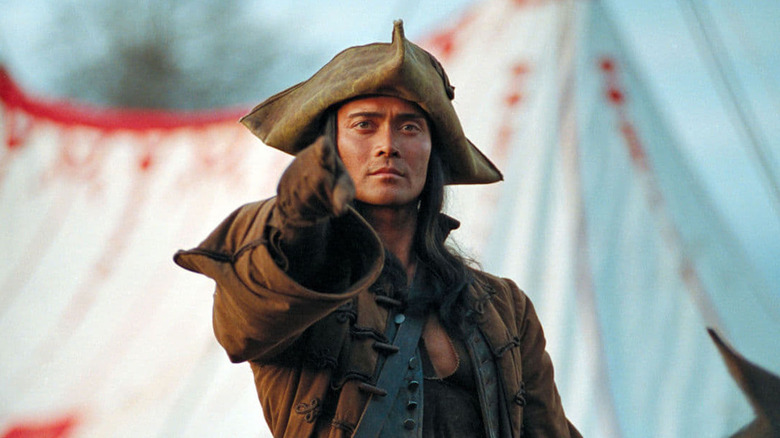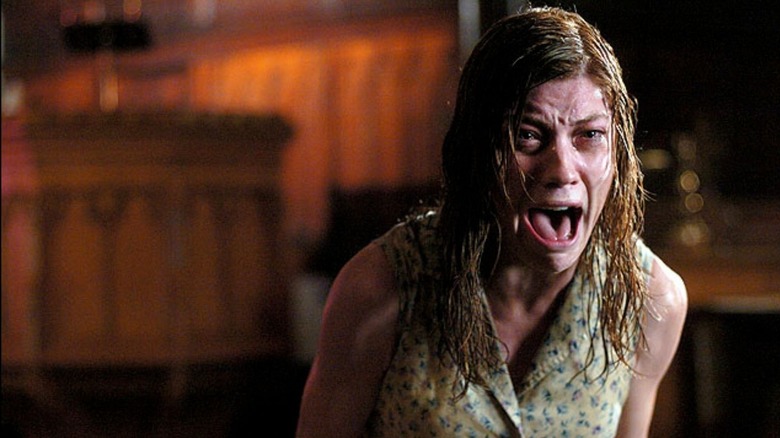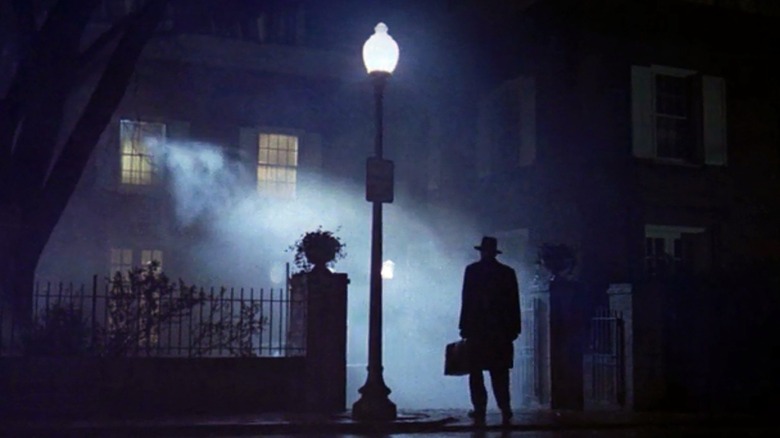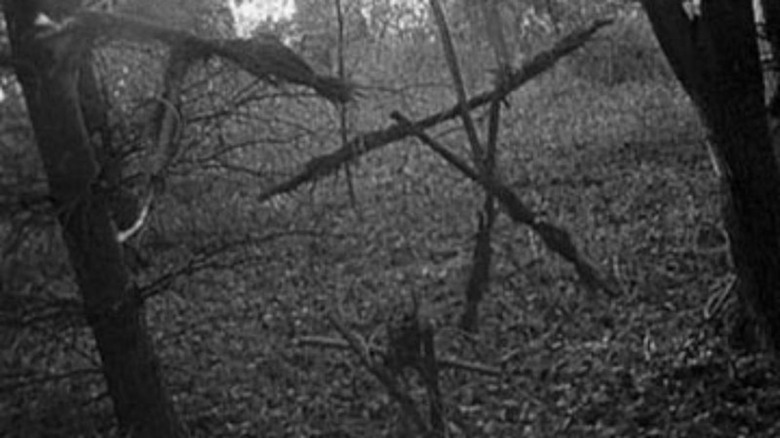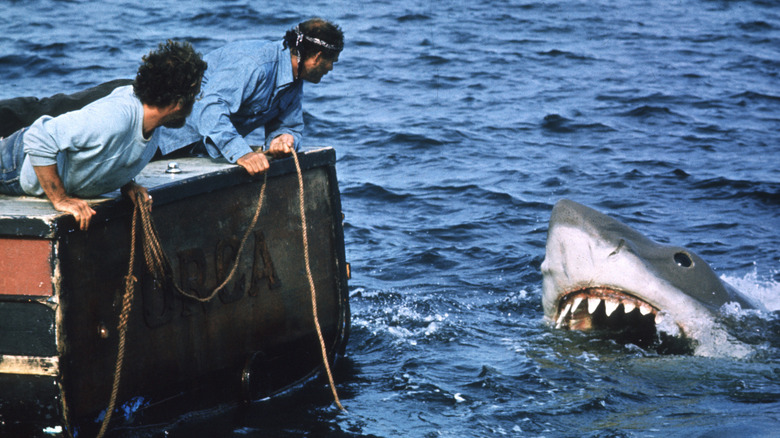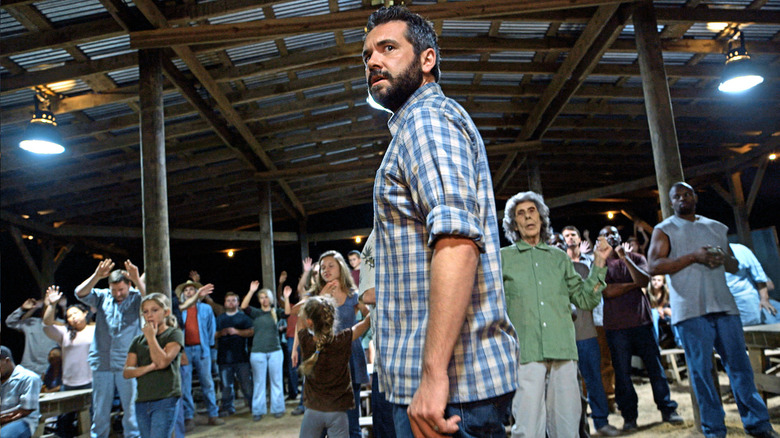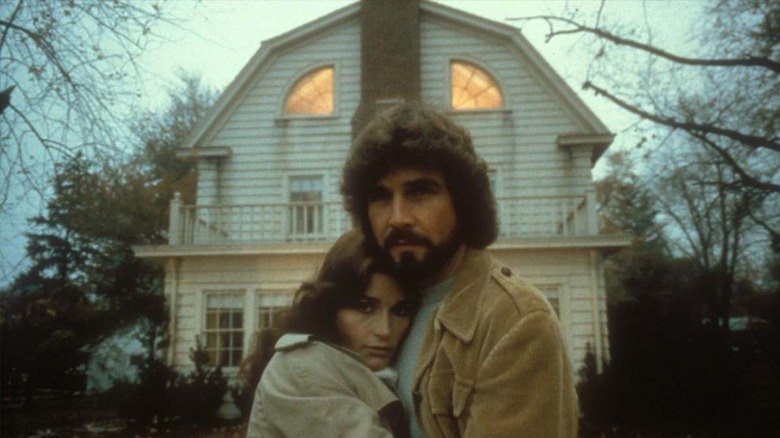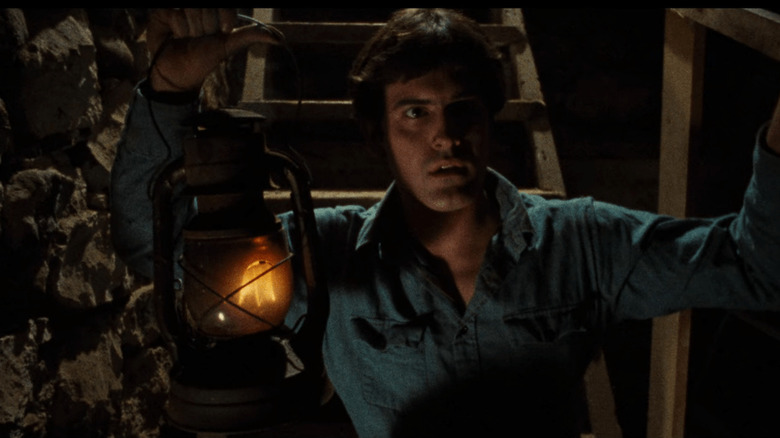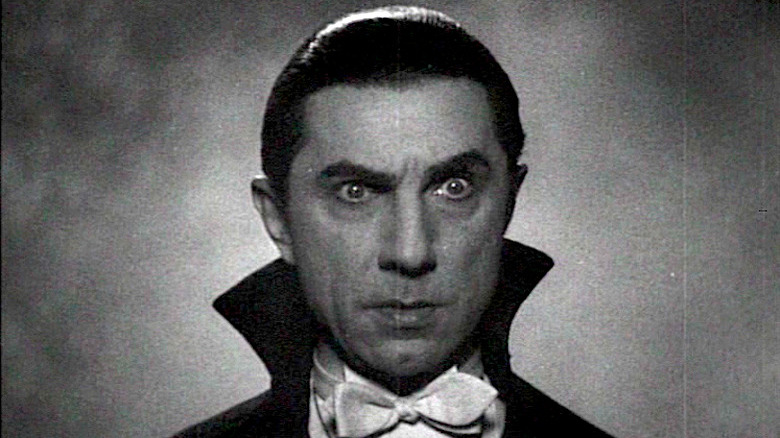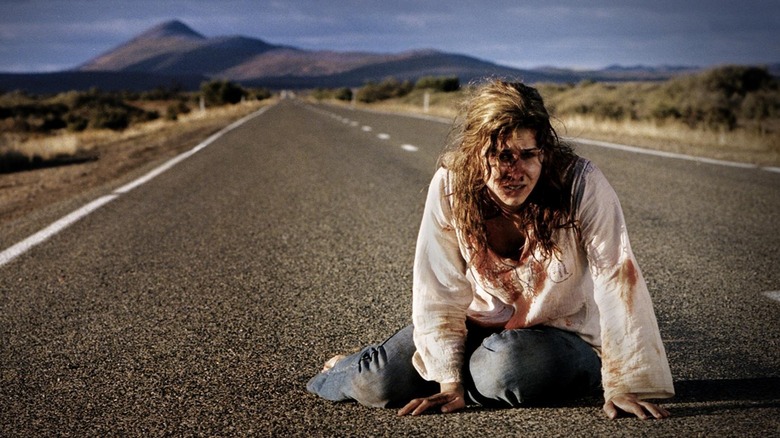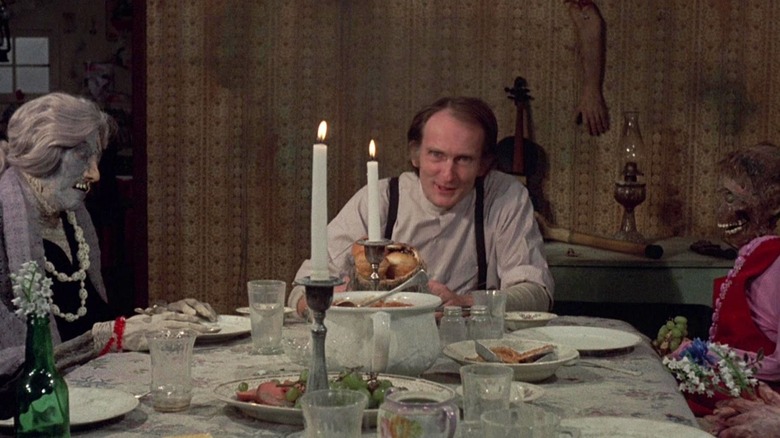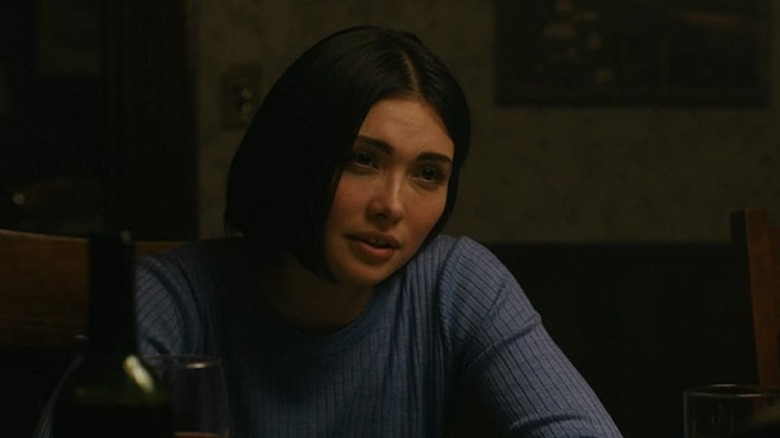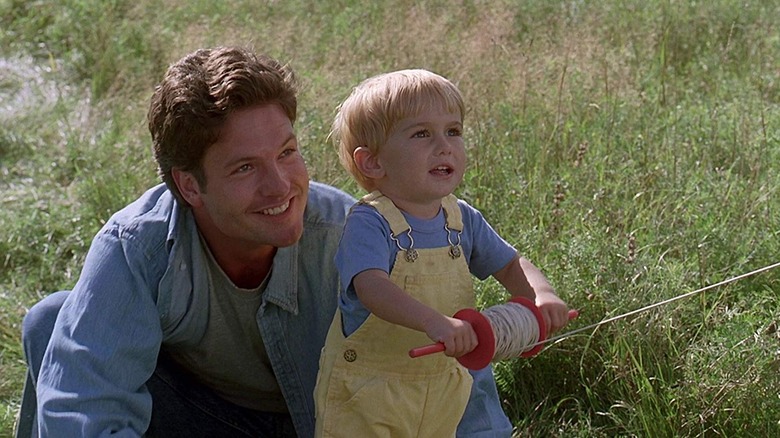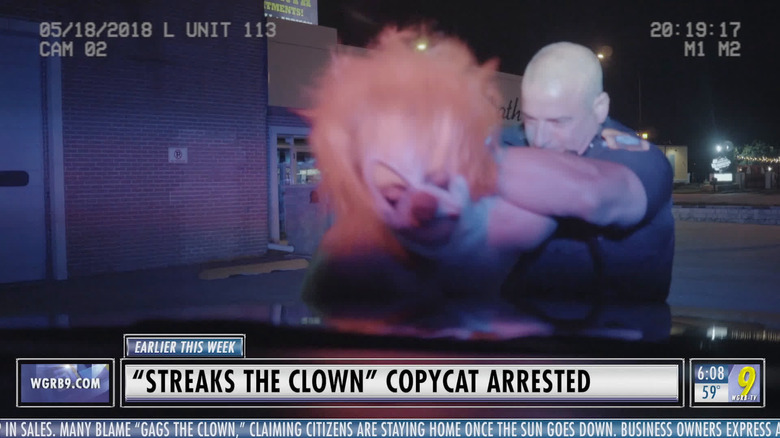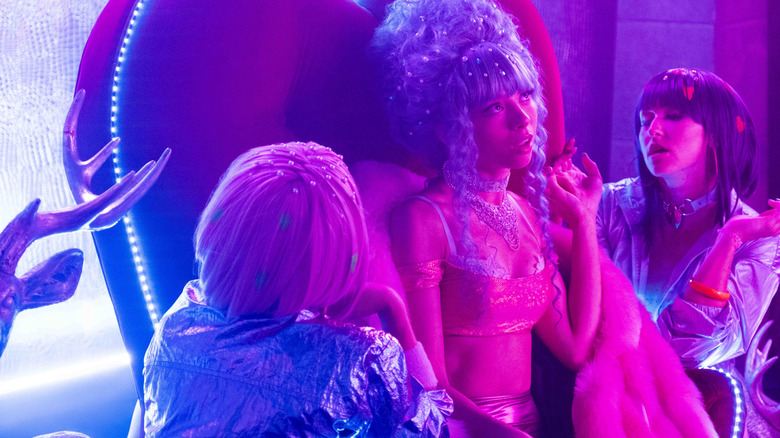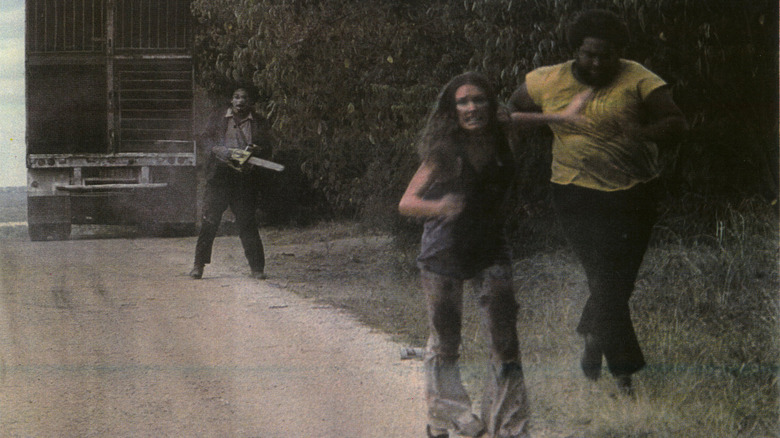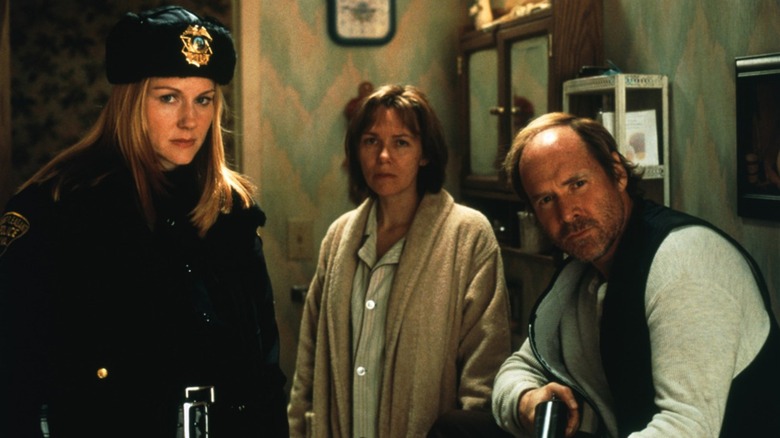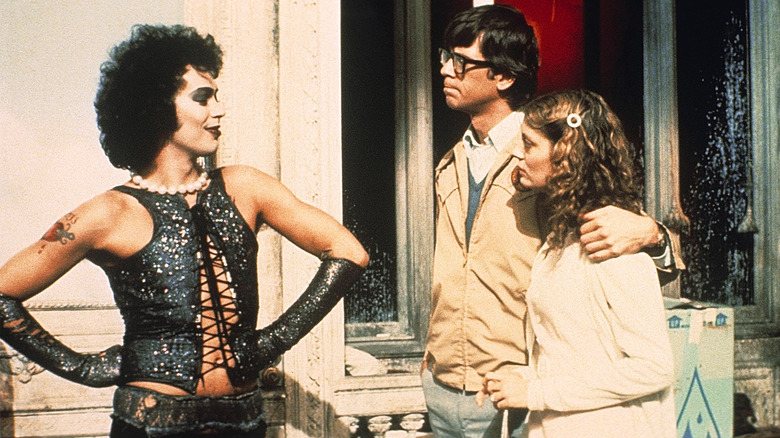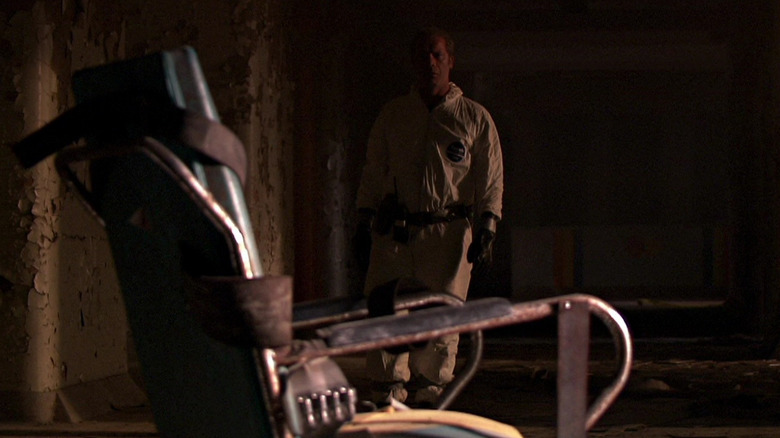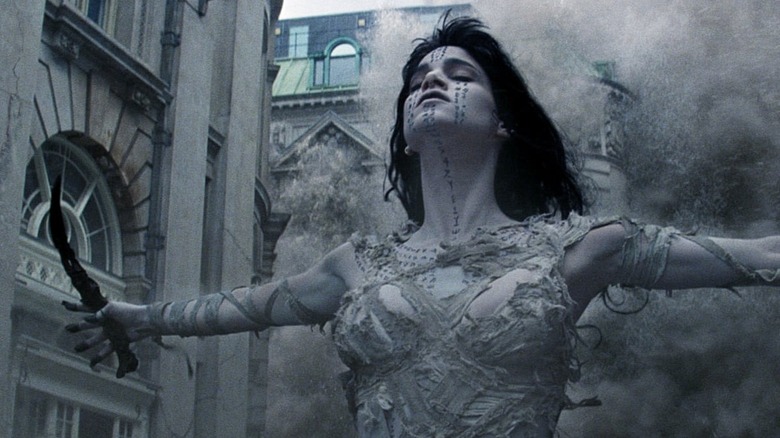23 Horror Movies That Are More Real Than You Realized
Every now and then, fact truly is stranger than fiction. Or in the case of scary movies, infinitely more horrifying. From wolf-like creatures in the French countryside and the far-reaching influence of Slenderman and Ed Gein to terror in the Australian outback, the most terrifying stories are sometimes true. Or at least loosely rooted in truth. In some cases, the process of making the film was so horrific that it made things a living nightmare for the cast, and marketing campaigns have occasionally been taken so seriously that the narrative runs wild, causing legitimate panic in the public. Sometimes, the shooting locations themselves come with their own sordid history,
Such is the case with these horror movies and franchises. Some of them were based on true stories. Others were inspired by real-life situations or loosely adapted from historical events, and a few were inspired by the deeply personal experiences of their creators. All of them are 100% terrifying.
A Nightmare on Elm Street
What do you get when you blend two real-life childhood traumas together? For director Wes Craven, the creator of the iconic "A Nightmare on Elm Street" franchise (among many others), the answer is Freddy Krueger.
Krueger is the dream-invading child murderer in the "Elm Street" series where he terrorizes teens by stalking and killing them in their dreams, ensuring that they also die in real life. He has helped define the slasher and has become one of the subgenre's most terrifying villains, which is fitting when you consider his origin story. The character is based on two personal instances in Craven's life. Firstly, he gets his name from Craven's childhood bully, "Fred Krueger." This bully had such an effect on Craven that he used a variation of his name in not one, but two of his movies (Krug Stillo in "The Last House on the Left").
His iconic look and general menace, however, come from a terrifying encounter Craven had with a stranger when he was a boy. In the audio commentary on the DVD, Craven describes seeing a man outside his family's apartment. The man caught Craven looking at him and decided to hold his gaze. He was wearing a fedora and "leering" up at the young boy. "That guy — whoever he was — enjoyed scaring the s*** out of a kid," Craven exclaimed, proving that childhood traumas really do have the ability to influence the rest of our lives. For some like Craven, they're inspirational, but for others, the effects can be devastating. (Miyako Pleines)
The Town That Dreaded Sundown
The 1976 slasher "The Town That Dreaded Sundown" and its 2014 sequel/remake are based on the real-life murder spree of the Phantom Killer, who terrorized the city of Texarkana on the Texas/Arkansas border in 1946. The Phantom attacked eight people in or near the city, killing two women and three men. The killer was never caught and to this day the crimes remain unsolved. Because the killer only attacked at night, and usually around the full moon, his spree became known as the Moonlight Murders.
"The Town That Dreaded Sundown" begins with a voiceover explaining that everything in the film is a true story and that only the names have been changed. While many of the details of the attacks are factual, director Charles B. Pierce and writer Earl E. Smith took creative liberties with characters and locations. In reality, most of the attacks took place in rural Texas, while the film depicts them as happening in Arkansas, but otherwise, the differences are small, like a victim playing the trombone instead of the saxophone.
The poster for "The Town That Dreaded Sundown" came under fire from locals because of its tagline, which claimed the killer "still lurked the streets of Texarkana." They worried that surviving victims and the victims' families would be impacted, but despite threats of litigation, the poster was never changed. "The Town that Dreaded Sundown" is often touted as the first true-crime slasher, but it does bring into question the moral implications of re-creating such traumatic events for entertainment, especially when the victims are still alive. The film also allegedly inspired teenager Gerald Gedrimas to murder his friend James Gunstra, reigniting the debate about horror movies leading to crime.
The city of Texarkana has made a tradition of screening the film every year around Halloween, giving residents a chance to have some spooky fun while honoring the horrifying history of one of the South's most notorious killers. (Danielle Ryan)
Rear Window
"Rear Window" is one of Alfred Hitchcock's greatest films; the 1954 mystery-thriller is widely considered one of the greatest movies of all time. The film centers around pro photographer L. B. "Jeff" Jefferies (played by Jimmy Stewart), whose busted leg keeps him confined to his apartment and peering out of his window, into a courtyard and the rear windows of his neighbors. One of those neighbors, Mr. Thorwald (played by Raymond Burr), may or may not have killed his wife.
Hitchcock's film is based on a screenplay by John Michael Hayes, adapted from Cornell Woolrich's 1942 short story "It Had to Be Murder," but for his part in the director's chair, Hitchcock told Francois Truffaut in the 1966 book "Hitchcock/Truffaut" that the plot of "Rear Window" was also loosely based upon two cases of uxoricide. Both the 1910 murder of Corrine Henrietta Turner and the 1924 murder of Emily Kaye, both allegedly at the hands of their husbands, served as partial inspiration for the thriller. Following Turner's death, her husband Hawley Harvey Crippen, who claimed she went out of state, made the grave mistake of giving his late wife's jewelry to his mistress, inadvertently leading to that scene in which Grace Kelly goes all-in on the Thorwald wife-killing theory because "The last thing Mrs. Thorwald would leave behind would be her wedding ring." The murder of Emily Kaye likewise inspired the "Psycho" director to have his characters searching for the missing head of Mrs. Thorwald, as Kaye's lover Patrick Mahon disposed of hers in a fireplace. Hitchcock quipped, "In all cases involving mutilation, you see, the biggest problem for the police is to locate the head." (Anya Stanley)
Brotherhood of the Wolf
Between 1765 and 1767, the rural region of Gévaudan, France was beset by a wave of vicious animal attacks that reportedly claimed the lives of over 100 men, women, and children. La Bête du Gévaudan, or the Beast of Gévaudan, ravaged the countryside. It was described as a "wolf, but not a wolf," and supposedly resembled a wolf-like canine with a massive tail that was as large as a horse (or larger). The extent of the attacks provoked speculation that there may have been more than one creature or even that it was a potential werewolf. Waves of hunters went out to Gévaudan to hunt the beast, and it was rumored to have been killed more than once, but the killings resumed until June 19, 1767. A local nobleman, the Marquis d'Apcher, organized a massive hunt, resulting in the death of a large beast with a reported mixture of wolf-like and non-wolf-like attributes. The attacks ceased.
The French action-horror film "The Brotherhood of the Wolf" recounts the monster's final, fateful rampages in France and the brave efforts to stop it. Grégoire de Fronsac (Samuel Le Bihan) and his companion Mani (Mark Dacascos) investigate a series of violent animal attacks, gradually discovering their unusual attributes, an iron tooth, and suspicions that it's mysteriously under human control. They discover that the beast is a tool of the Brotherhood of the Wolf, a secret cabal seeking disorder and control over France.
The film borrows heavily from the long train of real-life reports, adding its own unique layers of political intrigue and an original, plausible backstory for the creature itself — let's just say the film posits a very believable reason why the beast was so indescribable. It's a rare example of a monster movie that's based on a huge wave of real attacks which are, along with their creature, still shrouded in mystery. (Jeff Ewing)
The Exorcism of Emily Rose
Scott Derrickson's "The Exorcism Of Emily Rose" is a criminally underrated scare-fest, and combines two genres rarely seen together in movies — horror and courtroom drama. Starring Jennifer Carpenter as the titular Emily Rose who suffers from demonic possession, Tom Wilkinson as a priest conducting her exorcism, and Laura Linney as a lawyer and self-proclaimed agnostic defending him against negligent homicide, the film is inspired by the true story of a German woman named Anneliese Michel, who was 19 years old when she was diagnosed with temporal lobe epilepsy. After five years of taking psychiatric medications, Michel and her family consented to an exorcism in 1976. At that time, Michel suffered from grueling afflictions — she had seizures, demonic visions, ate insects, and performed hundreds of squats in a single day — and all of these behaviors were adopted by Carpenter's character in the film.
For ten months, Anneliese was restrained and subjected to 67 exorcism rites, some sessions lasting up to four hours. She eventually revealed that six demons possessed her — Lucifer, Cain, Judas Iscariot, Adolf Hitler, Nero, and Fleischmann (a disgraced priest), personalities that medics believed she assumed on her own. Michel soon stopped eating and died of malnutrition and dehydration, despite being under the care of her family.
Instead of making the film grotesque with visual effects (there's no green vomit or 360-degree turning heads), Derrickson relied minimally on CGI and heavily on the realistic performances from its cast — Jennifer Carpenter did all of her very alarming body and face contortions on her own. The film is teeming with fascinating questions about spirituality while focusing on the debate between science and faith. While the horror movie concludes that Emily was possessed, Anneliese Michel suffered greatly at the hands of people who imposed their beliefs onto her delusions, for which she paid the price. (Fatemeh Mirjalili)
The Exorcist
William Friedkin's adaptation of William Peter Blatty's novel of the same name, "The Exorcist," is an iconic Hollywood yarn about Regan MacNeil's exorcism. But did you know it's based on actual events? Blatty found inspiration in the late 1940s exorcism of "Roland Doe" (recently outed as NASA engineer Ronald Edwin Hunkeler) and even the Loudun possessions of 1634. Doe's supposed demonic battle involved levitating or throwing objects and markings appearing on his flesh. The Loudun nuns reportedly displayed more aggressively sexual reactions as summoned by priest Urbain Grandier who was eventually convicted of sorcery and burned at the stake. The church's efforts against demonic possession may not entirely be public knowledge, but the information that does exist lays a foundation that novelists and screenwriters couldn't write better themselves.
Both accounts prominently feature in Blatty's script and Friedkin's film, whether that's the whirlwinds whipping around Regan's bedroom or the infamously gratuitous crucifix scene. Actress Linda Blair lays in a bed that rocks like it's at sea and spews vile dialogue, much like subjects in Blatty's readings who proclaim to have been controlled by unholy forces. Friedkin's dedication to replicating the supposed effects of performed exorcisms led him to blast Regan's bedroom set with air conditioners to give his actors literal chills so their breath would show on camera. Blair remembers wearing a nightgown and long underwear while others around her were snug in old ski suits due to the below-freezing temperatures. It's a frigid price to pay for authenticity, which "The Exorcist" chased to be the most realistic exorcism tale possible (if you believe in battles between Heaven and Hell). (Matt Donato)
The Blair Witch Project
There may not be a witch haunting the woods of Burkittsville, Maryland, but the makers of "The Blair Witch Project" went out of their way to make the movie feel real to both their audience and their actors.
When "The Blair Witch Project" was released in 1999, its story of three wannabe documentarians searching for the truth about the legend of the Blair Witch, getting lost in the woods, and then succumbing to the witch herself was shrouded in intrigue that incited questions about its authenticity. Its faux-documentary style and inventive marketing, which included "Missing" leaflets with the actors' photos, an official website filled with Blair Witch lore, and a Sci-Fi channel mockumentary called "Curse of the Blair Witch," was designed to make audiences buy into the story. Of course, its found-footage filmmaking style certainly didn't hurt.
In order to elicit genuine reactions, directors Eduardo Sanchez and Daniel Myrick devised a setup that allowed actors Heather Donahue, Michael C. Williams, and Joshua Leonard a little independence. Armed with film equipment and a GPS that would lead them from one location to another, the actors really were alone in the woods, with no crew to hustle around them or the luxury of craft services. After setting up camp for the night, Sanchez and Myrick would ambush the actors by making spooky noises and running around their tents, all to evoke those scared, uncomfortable, and sleep-deprived emotions. Sanchez and Myrick even messed with the actors' rations, giving them less and less food each day.
While it might have been a lot of hard work for the cast and crew alike, in the end, they were able to capture something vital and real. The characters in "The Blair Witch Project" might have been searching for the truth, but in the end, they created their own legend. (Kaylee Dugan)
Jaws
"Jaws" is one of Steven Spielberg's earliest hits and remains one of his most influential. It created the summer blockbuster and, for a time, really got in people's heads when it came to sharks, with a terrifying depiction of the gigantic, oceanic beast. It's been well-documented that this depiction of sharks is not all that accurate. There was, however, one crucial scene that did involve real sharks, and their very real behavior affected the movie in a huge way.
Most of the film had employed a temperamental mechanical shark that the crew had nicknamed "Bruce," but Ron and Valerie Taylor were enlisted to capture some real-deal shark footage for one of the movie's most memorable scenes. In the scene in question, Matt Hooper (Richard Dreyfus) climbs into a shark cage and is lowered into the water to contend with the 25-foot shark causing all this trouble. But because real great white sharks tend to average closer to 15 – 20 feet, the Taylors had to get a smaller boat, use a smaller cage, and put a smaller actor inside of it to make it work for scale. Unfortunately, the actor was an inexperienced diver and was afraid of being around sharks. This led to an accident that changed the film entirely.
A large great white got caught in the wench that was connected to the cage and ended up breaking it off of the boat, leaving the cage to fall into the sea. Luckily, because the actor wasn't in it, they ended up capturing some incredible footage that made it into the movie. It also altered the story as Hooper was meant to die, but since the cage was empty in this real-life footage, it was changed so that he swam out the top of the cage, on his way to help save the day. (Ryan Scott)
The Sacrament
Ti West's 2013 found-footage horror film "The Sacrament" is a sadly accurate depiction of the real-life horrors of the 1978 Jonestown Massacre. In it, a Vice fashion photographer is invited to visit his sister, a former drug addict who claims to be living an idyllic life in a clean-living community led by a messianic figure called Father. Smelling a potential story, a Vice reporter and camera operator tag along and are taken by helicopter to Eden Parish, a community living off the land in a remote part of the world.
When Father fears that the Vice crew will bring the U.S. military down on their heads, he instructs his parishioners to drink poison in defiance of the society that seeks to imprison them. Instead, they will all die and move on together. I wish I could say that the darkest scenes of "The Sacrament" are embellishments, but the worst of them — syringes being used to squirt poison into babies' mouths, parents giving poison to their own children, and reluctant members of the congregation being murdered — are all based on real events that happened at Jonestown, the community founded by Peoples Temple leader Jim Jones. Though the location of Eden Parish is never made clear, Jonestown itself was located in Guyana.
Patrick, Sam, and Jake are fictional characters, but their experience is based on truth as well. U.S. Congressman Leo Ryan arrived at Jonestown shortly before the massacre, accompanied by a delegation of concerned relatives, reporters, and other politicians. As depicted in "The Sacrament," they were welcomed with a staged sight of cheerfulness and good spirits but were surreptitiously slipped a note from a frightened member of the People's Temple pleading for help getting out of Jonestown. The delegation later attempted to leave with a number of People's Temple defectors, but one of Jones' loyalists had joined them on the plane and began shooting. Ryan and several others were killed, and many more were injured. The total death toll was 918 people, of whom approximately a third were minors. (Hannah Shaw-Williams)
The Amityville Horror
In 1974, Ronald DeFeo Jr. took the lives of his father, mother, two brothers, and two sisters in Amityville, Long Island, New York. In December 1975, George and Kathy Lutz and their three children moved into the house only to leave 28 days later, claiming to have been terrorized by paranormal phenomena in a case that would come to be known as "The Amityville Horror." The alleged hauntings at the house in Amityville were the inspiration for Jay Anson's 1977 book of the same name and Stuart Rosenberg's 1979 film. They are also inadvertently responsible for "The Conjuring" films, as real-life paranormal investigators Ed and Lorraine Warren, the dramatized stars of the series, became household names after their work investigating the Lutz family's claims.
"The Amityville Horror" was a huge success at the box office and went on to spawn many, many sequels. As Amityville is an actual place, it is impossible for a film studio to trademark or copyright the name, which has led to countless filmmakers taking advantage of this loophole. As it stands, there are over 30 films that boast the "Amityville" name in the title, some connected to Rosenberg's original film, but most are not. While some have attempted to respect the very real tragedy that occurred before the alleged hauntings, most are offensive attempts to profit off of the legendary "based on a true story" name, with movies like "Amityville Vibrator" as arguably the most unforgivable. The Lutz family have steadfastly held true to their claims that the events described in Anson's book and in Rosenberg's film were "mostly true," but subsequent owners of the house have never reported any weird occurrences or supernatural activity. What is true, however, is that a family was murdered in that house, and grifters have been able to exploit the tragedy for nearly 50 years. (BJ Colangelo)
The Evil Dead
"The Evil Dead" isn't based on a true story, but filming the 1981 cult horror film was a nightmare all of its own. Writer and director Sam Raimi had to make his first feature with almost no budget, a cast and crew composed mostly of his friends, and a whole lot of hard work. Raimi's friend and the movie's star, Bruce Campbell, was candid about filming "The Evil Dead" in his 2001 book, "If Chins Could Kill." In the book, Campbell describes shooting at the rural Tennessee cabin as a "comedy of errors."
For starters, due to budgetary constraints, all 13 crew members had to stay at the cabin, which was cold, dirty, and had no plumbing. Because of the low-budget nature of the film, there wasn't much oversight, and several cast members were injured, including Campbell. One of the most horrifying moments involved Betsy Baker's eyelashes being ripped off when she removed her prosthetics. If that wasn't bad enough, the demonic eyes of the cast were created using thick contact lenses that essentially made the wearer temporarily blind.
Filming was so unpleasant that crew members began to leave one by one, and Raimi's use of "Shemping," or replacing actors with stand-ins, became an absolute must. By the end of the shoot, only Raimi and Campbell were left, and the two did reshoots for four days. That's commitment, and it paid off. While the making of "The Evil Dead" was miserable, it spawned an entire franchise and launched the careers of many of its cast and crew. Some of the sequences are still uniquely terrifying, in part due to the very real agony of the cast.
Thankfully, things got a bit better by the time they got around to "Evil Dead II," but the first film was a tough shoot. (Danielle Ryan)
Dracula
Few people, living or imagined, have inspired as many stories and re-tellings as Bram Stoker's "Dracula." Whether you've read Stoker's book or not, you're most likely familiar with the Count's immortality and thirst for blood. Often, it seems as if his image is as everlasting as a religious figure.
But where did Stoker get the idea for such a beautifully fiendish creature? Many believe he was inspired by the real-life ruler of Wallachia (now modern-day Romania), a man who was famous for his cruelty and his love of impaling his victims. The Dracula nickname, as explained by the Encyclopedia Britannica, came from Vlad's father who became a member of a knightly order referred to as "the Order of the Dragon." When this happened, his surname was changed to Dracul, meaning "dragon," turning young Vlad into "the son of Dracul," or in old Romanian, "the son of Draculea."
Dracula scholar Elizabeth Miller postulates that Stoker's inspiration came not from Vlad the Impaler himself, but rather this namesake. No mention of Vlad ever occurs in any of Stoker's research for "Dracula," but according to Miller, he does mention the modern Romanian word "drac" which Stoker understood to mean "The Devil."
While this is the most likely inspiration for the Count, there is no denying that Dracula and Vlad the Impaler have been tied together through a long game of historical broken telephone over the years. Even today, if you visit Bran Castle in Transylvania — a place Vlad never actually spent time in — you'll be met with images and souvenirs of Stoker's bloodsucking Count.
Origin stories often have a funny way of getting mixed around until only the juiciest bits remain, but even though Vlad may not be Stoker's intended inspiration for his Count, their sinful spirits live on together through all of film and literature. (Miyako Pleines)
Wolf Creek
Though the 2005 Australian horror flick "Wolf Creek" begins with text saying that it's based on actual events, the film is only loosely inspired by the real-life crimes of serial killer Ivan Milat in the early 1990s. Writer and director Greg McLean used elements of the case to spice up a slasher film he had written, trying to create an iconic Australian villain.
"Wolf Creek" follows a trio of friends backpacking in the outback. When their car breaks down near Wolf Creek National Park, they begin to panic until a local man named Mick offers to take them back to his place until they can fix the car. Mick turns out to be a serial killer, and he tortures and kills the two women backpackers, though the man escapes and is suspected of killing his two friends. Mick is never caught, and the movie ends with him walking off into the sunset, literally.
The killer that inspired Mick was Milat, who was convicted of killing seven people in 1996. Milat was suspected of numerous other murders, but they remain unsolved due to his death from cancer in 2019. Milat targeted backpackers and hitchhikers, and it is suspected that he might have "hunted" people alongside his brothers. One of the most shocking moments in the film has Mick turning one of his victims into a "head on a stick" by severing the spine, and he uses words that once came directly from Milat's mouth. The film's depiction of violence is graphic, with a tone so bleak that it makes "Silence of the Lambs" look like a Saturday morning cartoon.
By using the words and ideas of a real killer, McLean made his fictional one all the more terrifying. (Danielle Ryan)
Deranged
The name "Ed Gein" carries with it such notoriety that the majority of his heinous crimes need no explanation. The Wisconsin native has been dubbed The Grandfather of Gore, The Ghoul of Plainfield, The Plainfield Butcher, and The Plainfield Ghoul for his 1950s span of murders that claimed the lives of two confirmed victims, plus nasty business with the bodies of nine more already-deceased women claimed from local graveyards.
Medical authorities suggested that the flesh suits Gein made were an effort to become his late, Puritanical mother — Gein's only friend before her death in 1945. Gein's gravedigging and penchant for crafting clothing and decor from the bodies inspired many scribes to use him as a springboard for fictional rural killers. Among the best-known works that use Gein as an avatar is Robert Bloch's "Psycho," which was adapted into a proto-slasher feature film from Alfred Hitchcock. In it, Anthony Perkins plays Norman Bates, a mama's boy who kills his mother, her boyfriend, and later on, dresses as his dead mother and dispatches poor Marion Crane (Janet Leigh). The iconic Leatherface of "The Texas Chain Saw Massacre" films is another Gein inspiration, while in 1991, Jonathan Demme's "The Silence of the Lambs" earned Oscars for its adaptation of Thomas Harris' 1988 novel, which concerns an FBI trainee tasked to hunt down the Gein-esque "Buffalo Bill" killer, so named because they skin their victims to create a wearable suit.
But the underseen gem to watch is Alan Ormsby's "Deranged," a 1974 hicksploitation indie horror that holds a higher level of historical accuracy than most Gein works. The names are exchanged and Gein, now Ezra Cobb, is played by Old Man Marley, a.k.a. Roberts Blossom, from "Home Alone." But the gruesome details are all there, down to his final victim and capture, plus an eerie use of the hymn, "Who At My Door is Standing?" (Anya Stanley)
Mercy Black
When Owen Egerton's "Mercy Black" originally dropped on Netflix, the film struck audiences as simultaneously unique in its mythos yet intriguingly familiar. It follows Marina Hess (Daniella Pineda), a woman newly released from a 15-year stint in a psychiatric institute. As a child, Marina and another girl traveled to the woods to sacrifice their classmate to an entity named Mercy Black. Now released, Rebecca struggles to escape the legacy of her past as strange events build and take a possibly supernatural toll on her family. Outside the movie's world, there is no entity named Mercy Black. Rather, at the same time, the story's familiarity stemmed from its inspiration from unsettling real-life crimes.
The most direct inspiration for "Mercy Black" stems from a 2014 tragedy that saw two 12-year-old girls coax a friend into the woods, stabbing her repeatedly and leaving her to die. Their hope was to gain the approval of Slender Man, the faceless fictional suit-wearing entity that first emerged as a made-up creepypasta internet meme around 2009. Their victim survived and made it to the road to be saved by a nearby cyclist. The attack inspired the film's set-up and influenced the choice to center it on the mindset of the young attackers.
"Mercy Black" was also partially inspired by the case of the young Mary Bell, who intentionally killed two young boys as a pre-teen girl in 1968. After 11 years of imprisonment, she was released with court-approved anonymity, shaping the film's emphasis on the released attacker having to live with the consequences of their actions.
"Mercy Black" may be an original story, but its fictionalization of real crimes gives us a window both into how young attackers can engage in these heinous sorts of crimes and into the various and complex repercussions that can follow. (Jeff Ewing)
Pet Sematary
Like most authors, Stephen King draws upon real-life experiences when crafting his fiction, and "Pet Sematary" is one of his most "pulled-from-real-life" tales of terror.
In 1979, King became the writer-in-residence at the University of Maine and moved his family into a rented house close to the campus. The house was right by a major road that unfortunately resulted in many, many animal deaths. So much so that there was a nearby pet cemetery in the woods.
One day, the King family cat Smucky was run over, and they buried the doomed feline in that very cemetery. This event immediately set King's mind racing. "I can remember crossing the road, and thinking that the cat had been killed in the road," he later said. "And (I thought) what if a kid died in that road?" Of course, the mystical properties of the titular sematary aren't rooted in anything besides King's enviable and terrifying imagination. And, thankfully, his kids were safe from the passing traffic.
From this horrifying thought, King spun one of his bleakest, scariest novels; a book about a family moving to a new house near a college campus, where a nearby road is prone to heavy truck traffic, and a "pet sematary" lurks in the woods beyond. (Chris Evangelista)
Gags the Clown
As proven by Adam Krause's "Gags The Clown" (and a billion other examples), clowns are eternally creepy. Krause's indie follows a phenomenon in Green Bay, Wisconsin, as someone dressed in a head-to-toe clown costume strolls random streets late at night. Reporters duke it out for exclusive coverage while teens meet "Gags" face-to-face and realize his intentions might not be harmless. Gags and his bouquet of black balloons look like a joke to some, but as the voyeuristic fright flick eventually reveals, anonymous clowns aren't a laughing matter.
If the events sound familiar, that's because, in 2016, Green Bay residents were stalked by an unknown clown. Online evidence of said clown haunting parking lots under bridges eventually went viral for obvious paranoid reasons. Community members started posting counter pictures of how they would defend themselves should the unwelcome clown appear on their property. Still, the police couldn't retaliate or enact swift justice — the clown wasn't doing anything illegal.
Luckily for everyone, Krause revealed the "gag" to be nothing but marketing promotion for an upcoming horror short that would eventually lead to his feature adaptation, "Gags The Clown." "In a week and a half, the page has more than 50,000 likes on Facebook, and news stories have appeared as far away as Ireland, Brazil, and Germany." Local actor C.J. Guzan spoke up about the overnight urban legend before Krause claimed responsibility, citing panic as his reason. "It's getting a little bit scary because people are starting to believe it a little bit more. 'I can't go outside because I'm afraid of clowns or whatever.' That's just a little too far."
Krause would deny interviews at the time but then later announce that Gags was a movie villain only to be feared on-screen. (Matt Donato)
My Valentine
Hulu and Blumhouse's horror anthology "Into the Dark" has produced a lot of interesting stories, or at the very least stories with an interesting premise. But the second season film "My Valentine" feels especially sinister.
The film tells the story of Valentine Fawkes (Britt Baron), a talented musician who is just getting back into the swing of things after breaking up with her abusive boyfriend and creative collaborator. The twist here is that her ex-boyfriend, Royal, hasn't just moved on, he's created a newer and more popular version of Valentine with his new girlfriend Trezzure (Anna Lore), who is topping the charts. Trezzure doesn't just look and sing like Valentine — her hit song was also entirely stolen from Valentine.
Of course, things go off the rails from there, and the film spins a tale that includes multiple murders and a very annoying fan club, but the core of the story was clearly inspired by the relationship, and subsequent lawsuit, between LA musician Mars Argo, her allegedly abusive boyfriend and former creative partner Titanic Sinclair, and his new girlfriend and collaborator, the Grammy Award-nominated Poppy. In her 2018 lawsuit, which was settled out of court, Argo alleged that Sinclair "copied Mars Argo's identity, likeness, expression of ideas, sound, style" when he collaborated with Poppy. Argo even argues that Poppy died her hair the same shade of blond and mimicked her voice. Almost a year after the settlement, Poppy and Sinclair parted ways and Poppy released a statement accusing Sinclair of being manipulative.
"My Valentine" doesn't fully cover all of the details, and it spends quite a bit of time slipping a mixture of levity, murder, and mayhem into a story about abuse and control, but it does hew close to the complicated connection between Mars Argo, Poppy, and Titanic Sinclair. (Kaylee Dugan)
The Texas Chain Saw Massacre
Tobe Hooper's 1974 horror classic "The Texas Chain Saw Massacre" is a true staple of the genre and was deceptively marketed as being based on true events. Even though the Leatherface killings weren't real (though they were loosely inspired by real-life serial killer Ed Gein), the horrors that were experienced on the set of that movie were more real than one might realize. Gunnar Hansen, who played the iconic Leatherface in the film, has gone on record many times about the shoot. To say it was not fun would be a gross understatement, and he had every reason to claim as much.
The movie was filmed in the heart of Texas right in the middle of summer, filming in 100-degree weather or above on most days. That would be tough for any movie on a shoestring budget, and it certainly wasn't great for the actors, as they had to run, scream, and sweat in these conditions, while using the same clothes to maintain the look throughout the shoot. But Hansen, in particular, suffered more than the rest. His suit was made of wool and he had a heavy latex mask on for the entire shoot. Not only was that physically excruciating, but from a hygiene perspective, after a time, it got to be a lot.
By the end of the shoot, Hansen smelled so bad the other actors could hardly stand to be around him. But it was all in the name of cinema. To that end, Hooper was once quoted as saying, "By the time I finished the film, I think everyone hated me. Because I knew what I wanted and I knew how to get it."
A great many horror fans would probably tell you it was worth it. (Ryan Scott)
The Mothman Prophecies
"The Mothman Prophecies" begins with a sequence in which a giant red-eyed Mothman flies towards a car and causes it to crash, and from there goes on to feature Richard Gere receiving voicemails with predictions of future disasters. It might not sound like a movie that has much basis in truth, but in fact, this 2002 thriller is an amalgam of three different bizarre occurrences that all took place around West Virginia in 1966 and 1967.
West Virginia is known for being the home of a number of fabled cryptids, including two featured in "The Mothman Prophecies": the Mothman of the movie's title, and a creepy grinning man who goes by the name Indrid Cold. "The Mothman Prophecies" blends real-life stories of encounters with these two beings, never quite making it clear if Mothman and Indrid Cold are connected — or even the same entity. This is fitting, given that the first and most famous encounters with the two cryptids eerily happened in the same month: November 1966.
A group of four young people from Point Pleasant were driving along a road when they saw a large, gray figure with ten-foot wings and glowing red eyes. Over the following year, there were numerous other sightings of the Mothman in the area. Also in November 1966, in Parkersburg, West Virginia, a man called Woodrow Derenberger claimed to have spotted a bizarre-looking vehicle on his drive home, from which emerged a strange-looking man who spoke to Derenberger telepathically and identified himself as "Indrid Cold."
While the existence of Mothman and Indrid Cold remains unconfirmed, the collapse of the Silver Bridge at the end of "The Mothman Prophecies" was sadly all too real. However, while the movie suggests that the collapse was never explained, an investigation did in fact find the exact cause of the bridge's failure: a minute crack in a steel eyebar that was too small to detect at the time of construction, but which had weakened the eyebar over years of wear and tear. (Hannah Shaw-Williams)
The Rocky Horror Picture Show
Since 1975, midnight movies have been dominated by "The Rocky Horror Picture Show," Richard O'Brien's out-of-this-world musical of science-fiction, horror, rock 'n roll, sexual subversion, and embracing the excess. While the film is well known for its cheesy production value, ridiculous plot, and campy tone, the story behind its shooting location is far more sinister.
Now the Oakley Court Hotel, the "Frankenstein Place," as it is known in the film, was once a go-to spot for Hammer Horror films, but not before it was the site of unexplainable events and tragedies. During the late 1960s, parts of the Oakley Court were converted into apartment flats, with many residents describing the castle as "evil." There were reports of inexplicable sounds, ghostly apparitions, misfortune falling upon residents, and an overwhelming sense of dread, with many of the residents dying by suicide.
In 1971, a man drowned in the Thames, his body washing up near the grounds of the castle, and the Gallerneault family tragically lost two of their four children in a three-year time period while living there. When the castle was converted into a hotel, workers fled the grounds and many refused to work on the property after dark, reportedly seeing ghost-like figures, hearing unexplainable moaning, spontaneous glass shattering, tools going missing, and the electrical work seeming to have a mind of its own. Even today, guests of the hotel report seeing phantom images in photographs they take and hearing mysterious knocking sounds, but the alleged hauntings have become the biggest draw for guests. That, and getting to stay in the house-turned-spaceship that invited so many people to come up to the lab and see what's on the slab. (BJ Colangelo)
Session 9
"Session 9" has earned a vocal cult following since its 2001 release as supported by countless reassessments across the internet. Brad Anderson's supernatural thriller follows asbestos removers who win a bid for an abandoned insane asylum that presents abnormal working hazards. One of the crew uncovers a box of audio-taped patient sessions that detail a woman named Mary Hobbes' dissociative identity disorder. As the rush job agreed to out of financial desperation is plagued by mysterious occurrences, the tapes hold the clues about what still resides within the asylum's rotten bones. Gamblers disappear, fears are preyed upon, and something stalks the men around the premises. It's quite the blue-collar psychological descent.
If you're like me and were astounded by how Anderson pulled off such an authentic haunted atmosphere, the answer is quite simple — "Session 9" is shot on location.
No lots or sets. The Danvers State Hospital in Danvers, Massachusetts is the backdrop for every break in the workmen's sanity. The hospital opened in 1878 and earned a reputation for being one of America's most inhumane mental asylums. Production designers are said to have only touched up three rooms outside of the natural setting for atmosphere accents (meat hooks in the kitchen, surgical gloves in a tunnel, and parts of the hydrotherapy room). Actors Peter Mullan and David Caruso even admitted to supernatural occurrences on set, from figures passing by windows to voices suggesting leaps from rooftops. All the unease generated by dilapidation and corrosion in "Session 9" is the product of crack location scouting, possibly with spiritual squatters. Talk about a jackpot. (Matt Donato)
The Mummy
Lots of people don't know this, but the 2017 version of "The Mummy" starring Tom Cruise is 100% true and 100% accurate.
All of that really happened. Especially the parts with the mummies. (Chris Evangelista)

